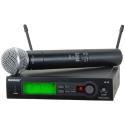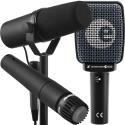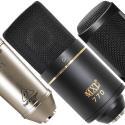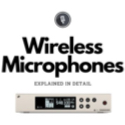What's a Lavalier Microphone? The Clip on Wireless Explained
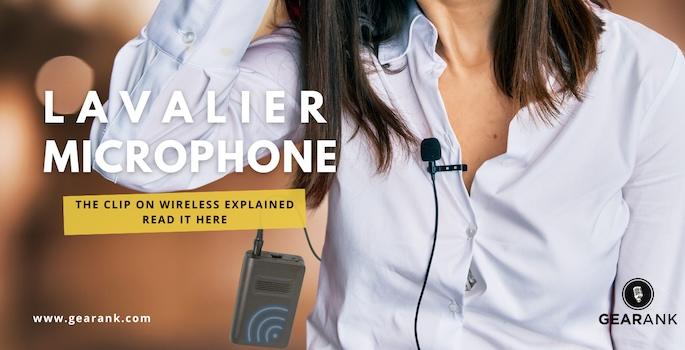
If you've watched an interview or have gone to the theatres, chances are, you've probably seen a small black foam dangling on the collar of the reporter or a performer. It's called a Lavalier Microphone.
What is a Lavalier microphone, and what do you use them for? Lavalier microphones are small, clip-on, hands-free mics most commonly used on stage and in front of a camera.
We'll look closer at these tiny mics and find out how they work and where you can use them.
What's A Lavalier Microphone?
A Lavalier microphone, or a lapel microphone, is a small microphone that you can easily attach to a performer's clothing.
It is lightweight and discreet, and it's heavily used in musical performances, TV shows, and interviews. It uses a microphone clip and is often attached near the neck, hence the reason why its sometimes called a neck mic.
This clip on microphones comes in wireless and wired options.
A wireless Lavalier microphone allows you to move around freely because the small transmitter pack of the wireless mic is neatly clipped onto the performer's belt.
A wireless Lav mic transmits the audio from the mic through radio frequencies wireless to the receiver, which is connected to the audio output.
In comparison, a wired Lavalier mic is a cheaper alternative to the wireless. However, it can restrict your movements because of the cables.
Nowadays, some wired lavs have been designed to connect to smartphones, offering the same convenience as a wireless one.
While Lavalier microphones can vary widely in quality and sound output, they are an excellent alternative to boom mics or other microphones.
Types Of Lavalier Microphones
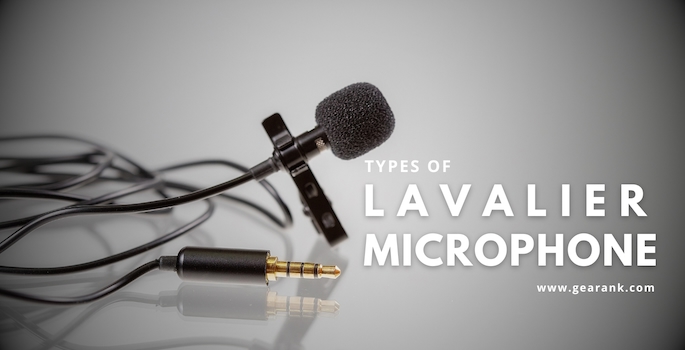
Besides wired and wireless Lavalier microphones, lapel mics will vary depending on their pickup pattern. Different pickup patterns (polar patterns) serve other purposes depending on the situation.
Omnidirectional Lavalier Microphones
Omnidirectional Lavalier microphones pick up sound equally well in all directions. They pick up audio in the distance first and the angle second.
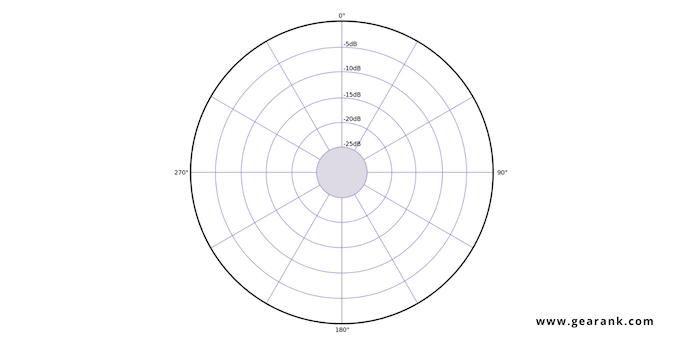
Omnidirectional Lavalier mics are suitable for most applications as long as the mics are close to the performer's mouth. You won't experience too much proximity effect and tend to respond well to plosive sounds.
These mics are also easier to set up. Since it captures audio at different points, it takes less time to find the proper mic placement.
Cardioid Lavalier Microphones
Cardioid Lavalier microphones are pickier than their omnidirectional counterpart.
While omnidirectional Lavalier microphones pick up the sound from all directions, Cardioid lapel mics only pick up sounds in one direction.
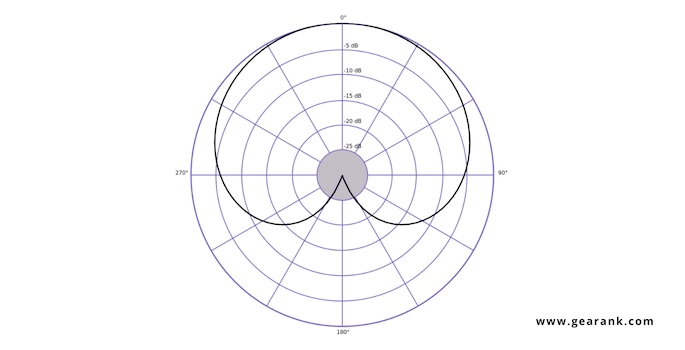
It will be sensitive to the sound in front and reject any interference with handling or wind noise from the sides and back.
With a cardioid lavalier microphone, you have to angle them correctly. Since they're directional, they're also prone to the proximity effect. Mounting them at the center of the chest is usually done to get the best audio quality from the speaker's voice.
Omnidirectional lav for:
-
On-the-go setup for interviews and live performances.
-
Field recordings that will capture dialogue as well as ambient noises.
Cardioid lav mics for:
-
Performances, filmmaking, broadcast TV, and public speaking.
-
Any sound recording that needs isolation from one source.
Pros Of Lavalier Microphones
Now that you know more about the Lavalier microphone definition, let's look at all the fantastic advantages of this small body mic.
Hands-Free
No need to hold the mic. The most significant advantage of Lavalier microphones is that you can attach them to your clothes.
When you move around on stage, wireless Lavalier microphones give you all the space and freedom to interact with your audience.
Little Setup Time
You can set them up within seconds, and you are ready to go.
This makes working with recording devices quick and easy. Ideal for sound engineers and stage performers, especially when you have a group of actors or artists who need omnidirectional Lavalier microphones.
Discreet
They are small, but these mics can still record clean audio. You can go undercover because Lavalier microphones are easy to hide. Thanks to their small size, you can clip them onto belts, tops, and pants.
Portable
If you are standing still, then a standard handheld mic works fine. However, if you want to move around, you need a portable lapel microphone. A Lavalier mic is best paired with a portable recording device, so you can record while moving around.
This is especially important when you have several performers, so they each have a mic around the neck that records their audio.
Cons Of Lavalier Microphones
Its biggest strengths can also be a disadvantage at times. Even with the best Lavalier microphone, here are some things you should check before recording.
Clothing Attachment
Working with a lapel mic means attaching it to belts, clothing, glasses, or other accessories. The rustling from clothes can be inconvenient for live sound and studio engineers as well.
With a lapel collar mic, it is best to test it beforehand and change positions if the rustling gets too distracting.
Varying Sound Quality
A good Lavalier microphone can serve as a good alternative for boom mics.
But due to its small form factor, sometimes the sound captured by lavalier mics can be a bit low quality compared to boom mics.
Each Lav mic will have a different sound from brand to brand—research before you buy the right Lavalier microphone for you.
Batteries
All wireless Lavalier microphones use a transmitter that is battery-powered. This means that you need to change and recharge batteries continually.
If you don't want the lapel mic to give up mid-performance, you must carry fully charged extra batteries with you at all times and regularly change before an important gig.
Another mic type that uses batteries is the shotgun mic.
When To Use A Lavalier Microphone
This also allows you to isolate various audio tracks and mix them or remove any background unwanted noise.
Wherever you use a lapel mic, remember that it records mainly the audio of the person who carries it. So, if you want additional sounds, I recommend using several lapel microphones.
You Need Freedom To Move Around
If you want to move freely on stage or prefer to hide your personal mic, then a Lavalier mic is a great option.
Remember that a Lav mic uses batteries as a power source, so you must remove it frequently to change the batteries.
Musical And Theater Performances
While Lavalier mics aren't used so often in the filmmaking industry, they are a popular piece of kit in theater and musical gigs.
Also, news programs and TV programs often use Lav mics if the presenters need to have their hands free.
Single Handed
If you are only a one-person band or crew and don't have a hand free to hold a boom mic, then a Lavalier microphone can be a great alternative.
You can clip the Lavalier mic on anywhere and record your audio.
How To Set Up A Lavalier Microphone
Here are some quick and easy steps to set up a lavalier mic:
Step 1: Attach The Microphone
First, you will need to find the correct position where you can attach the Lav mic.
Place the mic around 30-40cm away from the mouth. Avoid any rustling noise by attaching the mic to a collar, V-neck shirt, or suit jacket.
Step 2: Tuck In The Cable
Whether you have a wireless or wired Lavalier mic, it's ideal to hide the cables. Try to tuck the cables under the arm or under clothing to conceal them.
Step 3: Connect The Lavalier Mic To Your Device
Regardless if it's a wired or wireless microphone, you need a compatible connection depending on the device you're using.
Wired or wireless Lavalier mics with 3.5mm jack
Insert the Jack end of the mic into the Jack port of your PC or Mac. You can then use your standard audio settings to check the connection.
Through an audio interface
Using an audio interface for 3.5mm lav mics will be a much more complicated setup. An XLR to 3.5mm adapter will not work because an audio interface has a higher operating voltage (48v) than a wired Lavalier mic (around 1-10v, depending on the brand). You can't connect it to a 1/4 jack because lav mics need a power source.
As a workaround, you need to find an adapter compatible with this type of lav mic before you connect it to an audio interface.
If you have a wireless setup with a receiver, all you have to do is connect the receiver to the XLR slot of the audio interface.
Step 4: Test The Mic
Of course, you need to make sure that everything works properly.
I recommend double-checking the clip on the performer or presenter after a few minutes to ensure you don't end up with background noise or a muffled voice.
Final Thoughts
If you're a singer and pianist, you will love lapel mics because they enable you to sing and play the piano simultaneously. You can look at your hands while singing—no need to awkwardly position your head to the mic or fiddle with cables. You can focus on what's important: the music.
What's A Lavalier Microphone? There is no doubt that they are the most commonly used mics on the market. Due to how small, discreet, and hands-free they are, it's an excellent choice for podcasts, interviews, and theatre performances.
Frequently Asked Questions
What Is The Difference Between A Lavalier And Lapel Mic?
There is no difference between Lavalier microphones and lapel mics. They are the same type of wired or wireless microphone.
Both label microphones and Lavaliers can be attached to collars or tops, so you can easily record audio hands-free.
Where Is The Best Place To Put A Lav Mic?
The most accessible place to put your Lavalier microphone is on clothing, such as a collar, blouse, or shirt.
However, this can cause unwanted rustling noises, so the best place for a Lav mic is around the neck, on glasses, or on the ear.
How Should You Speak When You Are Using A Lavalier Microphone?
There is no specific way of speaking when you talk into a Lavalier mic. Just keep in mind that the microphone is directed at your mouth.
This means you might want to turn your head to the side slightly and speak as you would typically with another person.
How Long Do Lavalier Microphones Last?
Lavalier microphones can last for up to 10 hours. They are powered by AA batteries, so depending on the quality of your batteries, you can expect these mics to work for 10 hours.
Contributors:
Allen Articulo - Co-writer
Jerry Borillo - Illustrator




